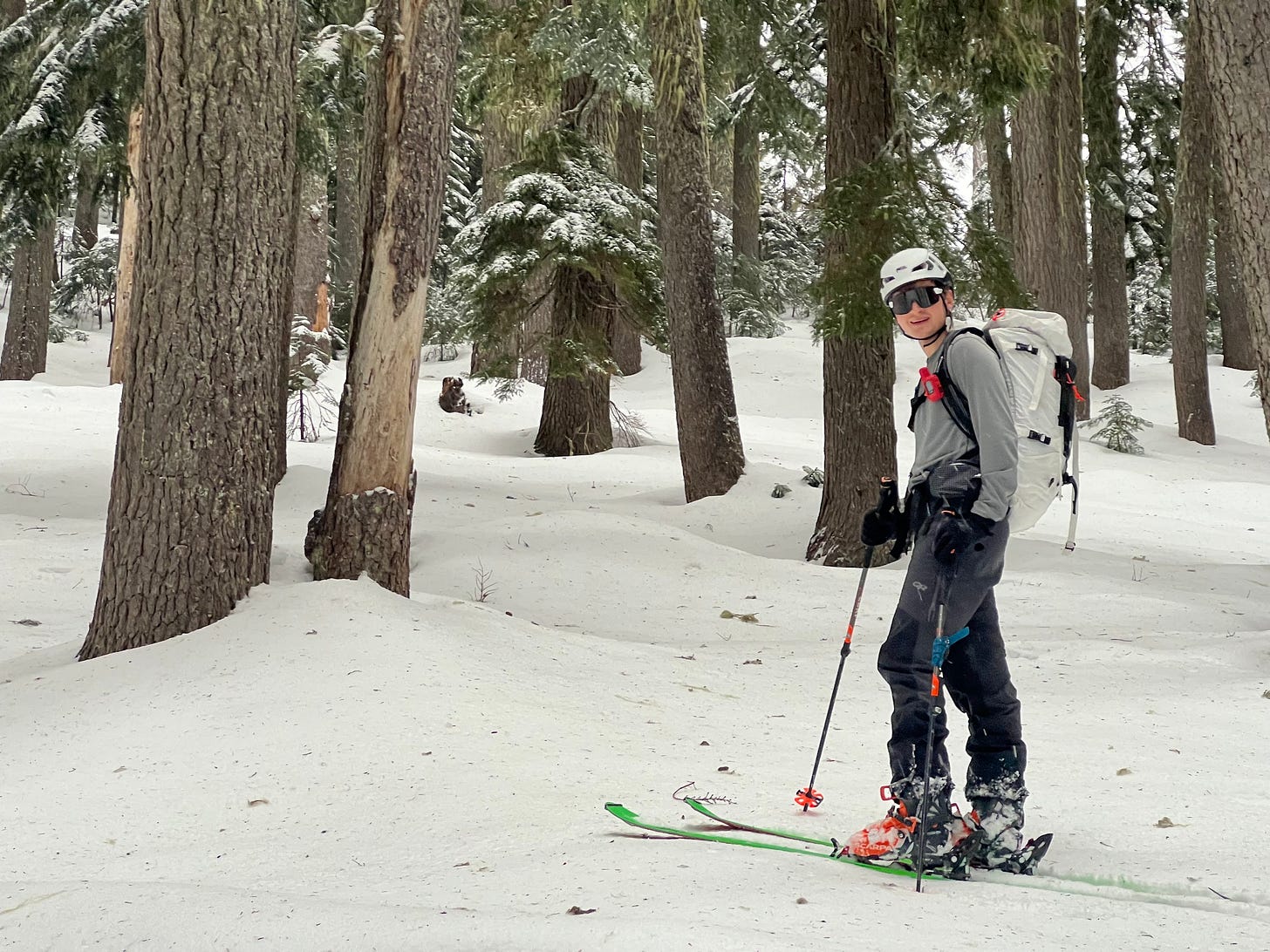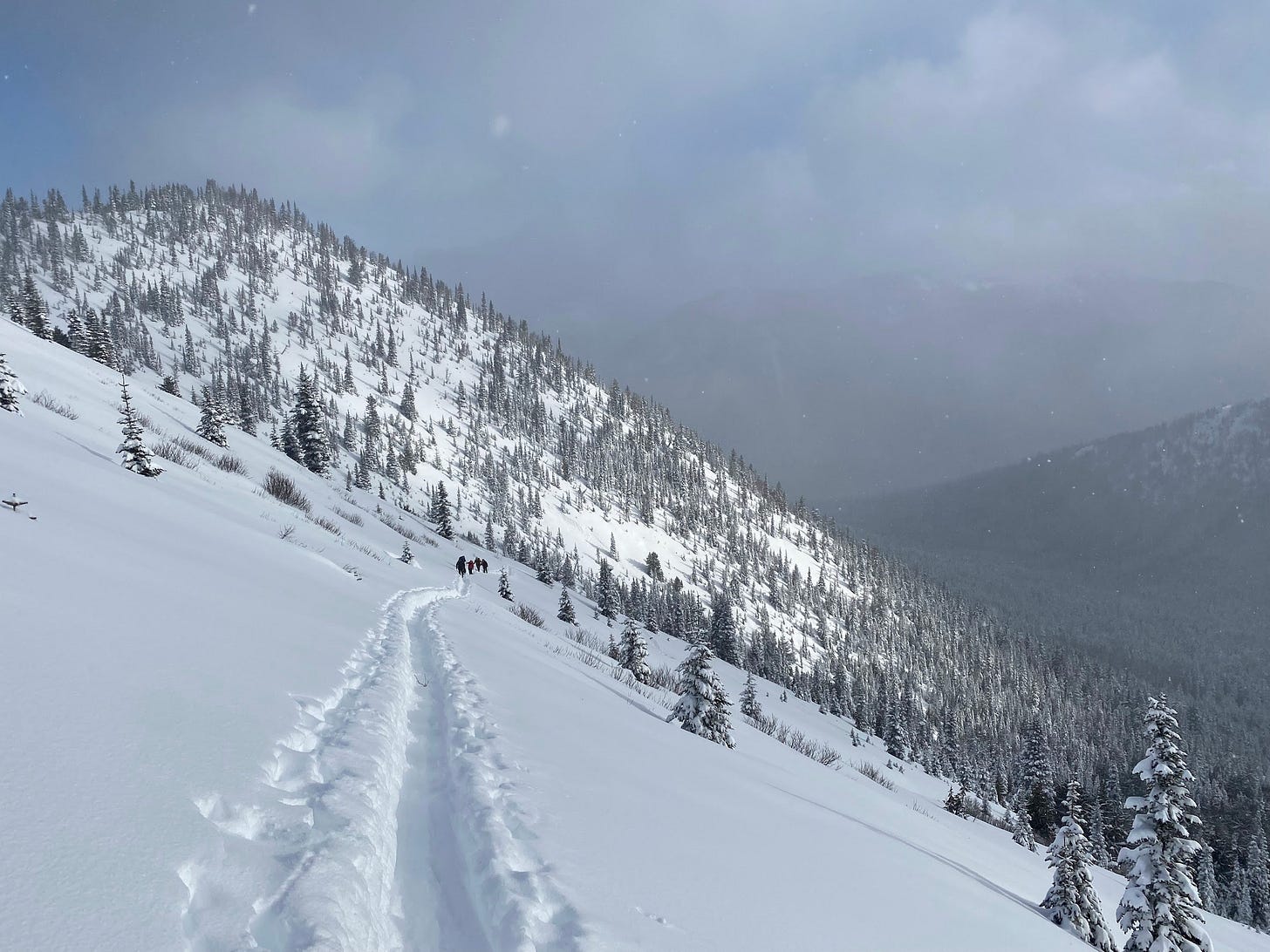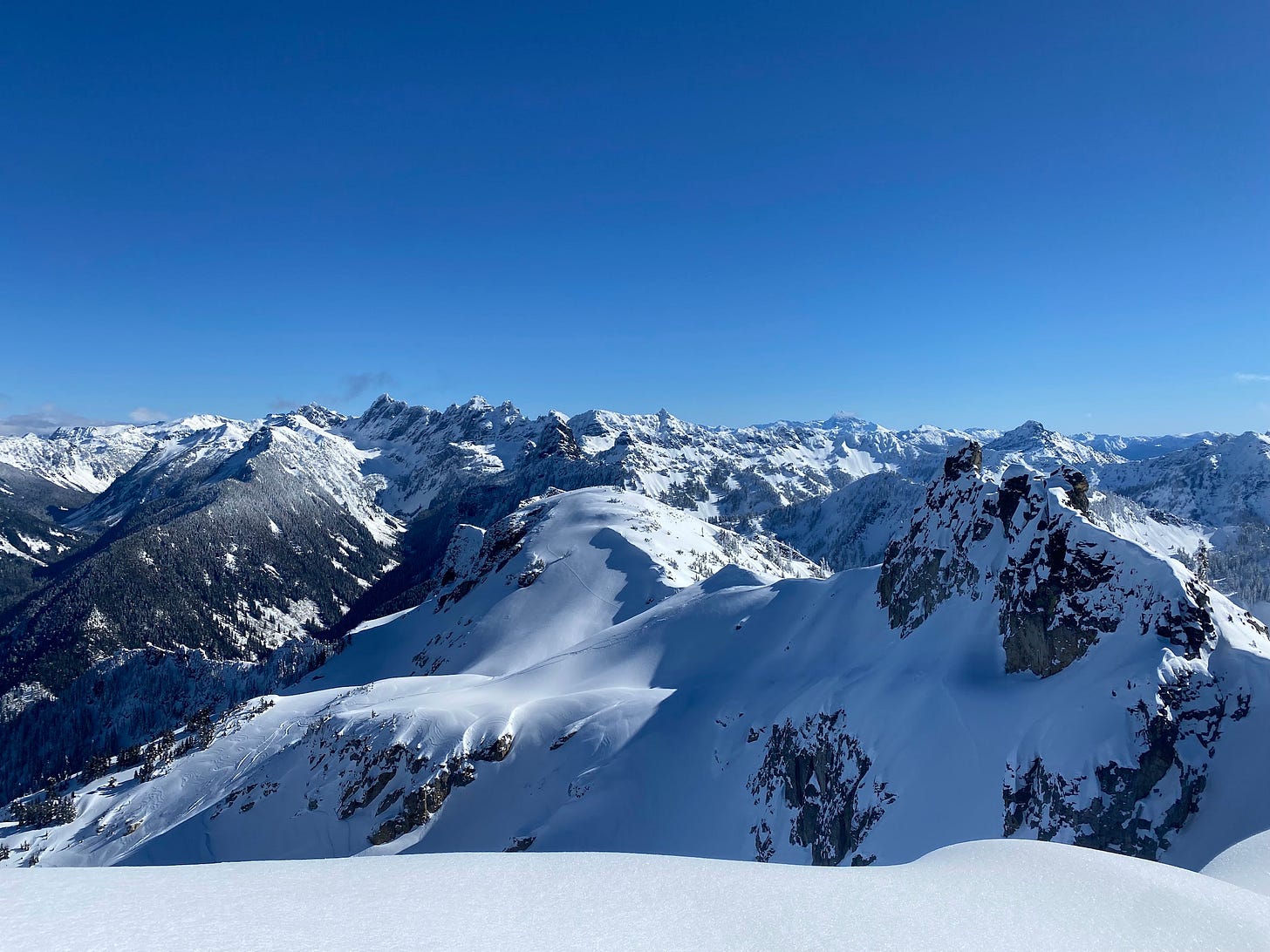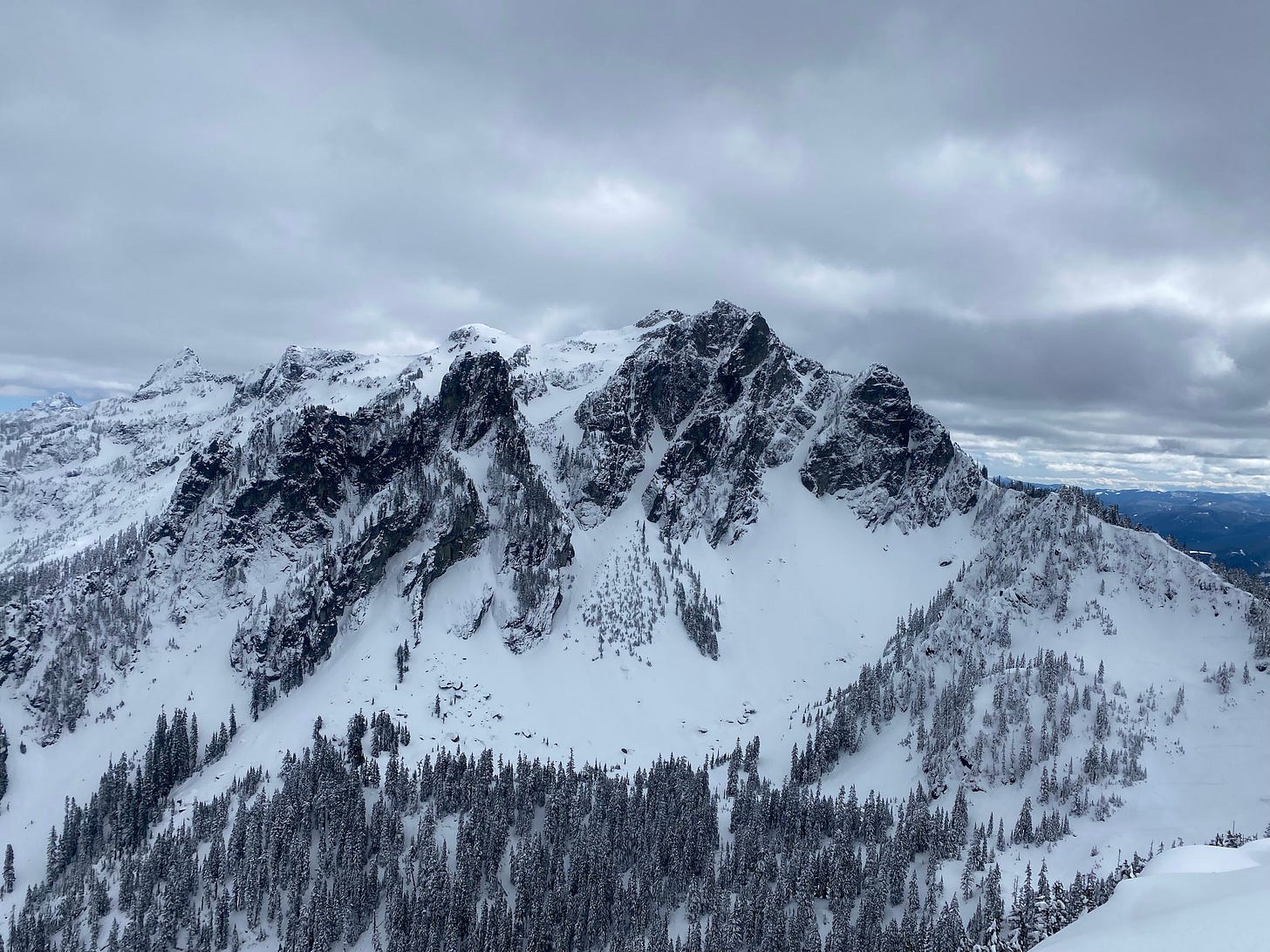What I Did on My Year Off, Part II
Skiing Mount Rainier, skiing Mount Olympus, and a whole lot of other skiing.
A major goal of my year off was to gain a lot of experience backcountry skiing. Having grown up ski racing and competitive running, ski touring is basically the perfect sport for me, and probably my favorite thing to do in the outdoors. But despite it being my fourth season of ski touring, I had spent the bulk of my previous four winters in Philadelphia, and as a result really didn’t have that much experience managing mid-winter avalanche terrain. Even relatively simple routes like the Chair Peak Circumnavigation still seemed intimidating to me at this point. So my goal for the winter was to gain a ton of experience managing actual avalanche terrain and ticking off a lot of the classic routes around Snoqualmie Pass.
A far off goal for the year was also to ski Mount Rainier in a single push. I had climbed it twice at this point, and felt like I had the technical skills, fitness, and skiing ability to pull it off. But it still seemed like a big objective. In any case, if I did do it I would have to wait until the spring, so for most of the winter this was hardly on my radar.
As you may recall, the 2023-2024 season was not a very good year for snow. El Niño delivered atmospheric river after atmospheric river, with very high freezing levels, followed by prolonged dry periods, which made for challenging ski conditions for much of January and February. Luckily, I’m not very picky with ski conditions, and still managed to get lots of days out touring in icy/otherwise marginal conditions.

A second crux of the year was finding partners. Unlike many other outdoor activities, backcountry skiing is something that I am simply not willing to do alone. But I really didn’t know that many people who were interested in backcountry skiing at the same level as me, and especially not people who were free midweek. So even though I was extremely free, finding good partners to go out with and capitalize on the rare weather windows was tricky. My partners basically came from four categories:
People I already knew: I had a few friends from ski racing, my summer in Alaska, and high school who backcountry skied. This accounted for a few days of touring, but I definitely had to meet more partners beyond this initial pool if I wanted to make the most of my winter.
My dad, and my dad’s friends: I am lucky to have a father who also enjoys backcountry skiing. Unfortunately, he broke 4 ribs at the beginning of the winter, so was out of commission for much of the season. Later in the year, though, he was a pretty consistent weekend partner. My dad also has various friends who are experienced backcountry skiers, who I went out with a few times. In a perfect world, I’d rather tour with people closer to my own age, but at least old dudes tend to be relatively safe and competent.
People I met through the Mountaineers: I joined the Mountaineers club, and signed up for their Winter Mountaineering and Advanced Crevasse Rescue course. I also went on a couple of official Mountaineers backcountry skiing trips around the Crystal Mountain backcountry, which were fun days out in and of themselves. This gave me access to a decent pool of partners—mostly tech workers in their late 20s and early 30s who were only free on weekends. Competence levels were also pretty mixed, especially with respect to skiing ability and fitness. So it was slow going meeting people this way, but I did find 2 or 3 really excellent partners who I ended up doing a lot with later on.
People I met while out skiing: These are by far the most fun connections to make. I participated in the weekly Wednesday night Hyak Skimo Beer League, where I met lots of speedy skimo dads in their 30s and 40s. I made a lot of good Strava connections this way, although they didn’t lead to many touring days out during the season itself. I think if I were to spend a second season in Washington, I would get out with a bunch of these people though, so it was still time well spent (and skimo is a super fun anyway). Finally, one day out touring by myself up the Silver Fir chair at the Summit, I randomly met one of my main partners for the year, a super fit firefighter named Gian (pronounced ‘John’) who I did a bunch of laps with. I was lucky to be wearing my light skis that day, because otherwise there would have been no way I could have kept up.
All of this is to say that meeting good partners was hard. By the end of the season I had a pretty good pool of people to ski with, but at first it was very slow going. Nevertheless, I still managed to get out for about 40 days of backcountry skiing between November and July. Here were some of the highlights of the season:
My season started with an AIARE 2 class with Pro Guiding Service. This was in mid-December, so there was barely any snow at this point, but it was still good to refresh my avalanche decision-making skills.
January and February were very slow. I still got a bunch of days in, but they were mostly unremarkable. There were a couple of storms, though, including one truly incredible powder day with a Mountaineers group in the Crystal Mountain backcountry. I think this was my first ever day being out in ‘considerable’ avalanche danger, so I was pretty on edge, but we managed find some of the deepest powder that I have ever skied on the south face of Crown Point. It was pretty awesome.

At the end of February, things started to pick up. This began with a really perfect day completing the Chair Peak Circumnavigation with a partner I had met through the Mountaineers, Juliette. This was our first tour together, but Juliette turned out to be a really competent and fit touring partner, so it was a really great day out in perfect weather, even though the skiing conditions were still pretty bad. A highlight of the day was skating across Snow Lake in about 10 minutes, something that is rarely possible on this tour.
After this it finally started snowing, and I got a bunch of great powder days in Kendall Trees, Phantom Trees, and the area around Mount Margaret (a hidden gem for tree skiing). A highlight of this week was going night backcountry skiing with my dad’s friends in the Kendall Lakes area. We started at 4pm, then skied blower powder by headlamp until around 10pm. It was super unique, and something I’d definitely do again.
Shortly after this I finally got to ski the Slot Couloir, another one of my main objectives for the season. Juliette and I went out for a long day in the Alpental backcountry, both of us skiing the Slot, Avalanche Mountain, and the Cache Couloir for our first time. It was another super beautiful day in Washington, with sunny skies at the beginning and a very moody layer of clouds at the end.


It was already March at this point, so soon enough it was time to start thinking about spring objectives. The first objective along these lines was a summit attempt of Mount Shuksan via the White Salmon Glacier. The avalanche and wind conditions looked good, so 3 of us left Seattle on a rainy Saturday afternoon and drove up to Mount Baker Ski Area, where we slept the night in the parking lot. The drive up was very wet, but the weather cleared overnight, and it was really cool to wake up to completely clear skies.
We started up the route around 5:30am. This involves skinning up a groomer in-bounds for a few hundred feet, then transitioning and skiing down to the valley floor before beginning the climb in earnest. The ski down to the valley floor didn’t have quite enough snow, so was a bit exciting in the dark, but it all went smoothly enough.
The rest of the climb up the White Salmon Glacier was great. Another party had made a perfect skin track for us, and conditions seemed quite safe. We quickly made it to the top of Winnie’s Slide.

Skinning up just below Winnie’s Slide, with the summit of Mount Shuksan still looking very far away. Above Winnie’s Slide, unfortunately, the wind was much stronger than forecast. The skin track was also quite icy through this section, and somewhat exposed. We used ski crampons, but really should have just booted it. We ran into the group in front of us, who were turning around because they had triggered a wind slab while traversing across the top of the hanging glacier. Since we were going a different direction than them, and weren’t currently in avalanche terrain, we decided to go a bit further, and see how it looked.
We continued up to the top of the Upper Curtis Glacier, and even skied down to the base of Hell’s Highway, where we finally decided to turn around due to avalanche concerns. It was a long way out from here, especially the final climb back up to the Mount Baker Ski Area, but the White Salmon Glacier skied really well.
The next weekend I returned to the Mount Baker area to ski Ruth Mountain with my dad. The Hannegan Pass road had just about melted out to the trailhead at this point, so we were able to ski it in perfect winter conditions with minimal walking or other annoyances. This was one of the best days of the winter, with really incredible scenery and snow. The view from the top is just ridiculously good. We didn’t see anyone else all day, but to make things even better, on our way out, we ran into another group that had gotten pictures of us skiing down! Enjoy these photos.

After only a day of rest, I had one of my biggest adventures of the year. There was a really nice looking weather window, and Gian texted me asking if I wanted to ski Mount Olympus. Mount Olympus is not a common ski objective, due in large part to the fact that to get to the mountain you have to walk about 15 miles of trails both ways with skis on your back. Nevertheless, it was a cool objective, so I said yes, and our schedules ended up working out so that we would have a day and a half to do it.
So, the next morning, I met Gian at the Hoh Rainforest visitor center just before noon and we headed off, planning to walk as far as we could before it got dark. After about 16 miles of walking, and a few tricky miles of skinning, we made it to a snow-covered Glacier Meadows campground just after sunset, where we set up camp, melted water for several hours, then went to sleep around 11pm.
The next morning, we woke up around 5:30am, made breakfast, then left camp to climb Olympus around 7am. Ironically, in the morning we found a perfect water source only about 100 feet from where we had camped. We hadn’t seen it the night before because it was dark when we got there, leading to tons of unnecessary work melting water.
I was already pretty tired at this point, and was quickly realizing what a super-athlete Gian is. We climbed up to the top of the moraine, quickly downskinned to the Blue Glacier, then roped up, crossed the Blue Glacier, and started climbing for real.
As we crested the Snow Dome, it became pretty clear that we wouldn’t be able to take the direct “4th of July” route to the summit, and so instead would have to take the long way around through Crystal Pass. There was also a bunch more snow than we expected on the summit block. We had carried cams all the way in so that we could get to the true summit, but these obviously wouldn’t work if the rock was still icy (or completely buried in snow). So we decided to not climb the summit block.
Instead, we made it to the highest point we could reach on skis (the saddle right below the false summit), then enjoyed a long ski down back to the Blue Glacier. The views of the Bailey Range and Valhallas were absolutely stunning. There is so much ski terrain to explore out there.
We roped up one more time to ski across the Blue Glacier, then climbed back up the moraine, which was surprisingly loose and sketchy in ski boots. We then skied a few more turns to camp, broke it down, and began the very long walk out, with the goal of making it back to the cars before sunset.
This was where Gian really kicked my butt. I had made the mistake of wearing approach shoes for the walk in (to make climbing the summit block easier), which were just too stiff to walk 30 miles with a heavy backpack. With about 8 miles to go I was really struggling to move any faster than 2.5 miles per hour. Meanwhile, Gian was still going strong, and even suggested running out at one point. It was a real struggle, and to make matters worse it started raining during the final miles. But I still made it back to the cars just after sunset and drove back to Seattle that night (with only one nap along the way). We both agreed that Olympus would be a really popular skiing objective if it just weren’t so far in there.
After a few more unremarkable ski tours, I spent most of April learning to trad climb, and as a result skiing much less. One highlight, though, was a birthday ski tour of Mount Ellinor with my dad, including the northwest couloir, which is a really great ski run (and would be so good in powder…).
May was even less eventful than April, but I did have the super cool opportunity to participate in the inaugural Kulshan Randonnée skimo race as a last minute addition to a team. Even though the course had to be shortened due to poor weather, the event was incredibly fun, with a ton of really well known ski mountaineers from the Pacific Northwest and beyond showing up to race. I’m jealous I won’t be around to participate in future iterations of this event.
On the last day of May, I also did the Birthday Tour with my dad. Conditions were perfect corn, and scenery was superb. This was also my first time visiting the Washington Pass area since I was 10 or so.
Overall, it was a tricky spring for corn skiing, resulting in fewer days out than I might have expected. By June, I had mostly moved on from skiing, focusing instead on alpine climbing and trail running. But I knew that I still wanted to try to ski Rainier if there was a weather window. Luckily, two of my ski racer friends also really wanted to ski Rainier, so we spent most of June waiting for the right opportunity. We also all decided that the Emmons Glacier seemed like the most manageable ski route for us (the only real challenge being the skiing, which was not an issue for us since we are all super experienced skiers).
We tried for Rainier for the first time on June 8th or so, about a week after a massive atmospheric river had left multiple feet of fresh powder on Rainier. We started up at 9pm, aiming to summit the next morning around 10am. Conditions were passable, but we had to turn around at Camp Schurman because someone in our group ran out of energy. So we skied the Interglacier completely in the dark and arrived back at the trailhead almost exactly at sunrise. It was for the best, though, because according to other people’s trip reports the upper mountain was terribly icy and not fun to ski that day.

Rainier at sunset from just beyond the White River Campground, right before we spent all night climbing to, then descending from, Camp Schurman. For a while after this, it looked like we might not get another window to ski Rainier. My friends were only free on weekends, the winds were high, and the climbing rangers seemed increasingly convinced that upper mountain ski conditions were terrible. However, during the first week of July, a heatwave arrived, and there seemed to be a plausible weather window on July 4th, where it was hot enough for things to soften up near the summit, but not yet hot enough to be dangerous. So we decided to go for it again.
We ended up totally nailing the timing. We left the White River Campground around 9pm on July 3rd, then climbed slowly but steadily through the entire night, summiting the next morning around 10am. We had discussed the possibility of walking down from the summit—instead of skiing—if conditions were too bad. But it was already clear that conditions were much better than on our previous attempt, and all the crevasses seemed to still be quite well bridged, so we had few reservations about skiing down. The scenery, of course, was extremely good.
We were the first ones to the summit that morning via the Emmons, which was surprising. Some guided parties were coming up behind us from Camp Schurman, which was reassuring that we hadn’t timed things incorrectly. Still, I thought these groups were on a surprisingly late schedule for having to walk down afterwards. Randomly, I ran into my friend Tory on the summit, who was working as a guide for IMG and had just reached the summit with some clients. I hadn’t seen Tory since living in Alaska two summers ago, so it was nice to say hello.
We started skiing down around 11am. Ski conditions from the summit to the Liberty Saddle were terrible, but after this they turned firm but edge-able through most of the consequential terrain on the upper mountain. We followed our up-track almost exactly, while skiing slowly and perfectly in control, but still linking turns.
We decided to take our skis off and rope back up to cross the biggest crevasse on the way down. Afterwards, we put our skis back down and skied the corridor, which at this point was complete mush. The entire slope was also covered in people’s plunge steps from the previous days, so skiing this section was really strenuous and unpleasant. Still, we quickly reached the base of Steamboat Prow, and made the painful, very hot 400-foot ascent back up to the Interglacier.
Ski conditions improved on the Interglacier, and we managed to ski continuously all the way to 6,000 feet, right before reaching Glacier Basin camp. Pretty good for July 4th! We passed about 50 people coming up the Interglacier on skis, planning to summit the next morning. I wonder how their attempts went, because I think it would have been significantly harder to time things correctly the next day with higher temperatures. It definitely pays to be fit enough to do Rainier in a single push.
After the final 3 miles of walking back to the car, we were all very happy to be done. It was 3pm at this point, and it was pretty surreal to think about how we had been moving continuously for 18 hours at this point. I was very happy to have completed my main ski objective for the year, and will definitely be returning to ski other routes on Rainier in subsequent seasons.
After this, I was ready for ski season to be over, but I still got out for a final few turns of skiing in August with Gian. We skied the Chair Peak snow patch, and to make the walk up there worthwhile we also climbed the 8 pitch 5.8 sport climb Voie de Chaise to the summit of Chair Peak. Another great day out.
In all, it was a great ski season, and I improved a lot as a backcountry skier. It might be a while before I spend another winter in the Pacific Northwest, but there are definitely a lifetime more of ski adventures waiting in store.






































